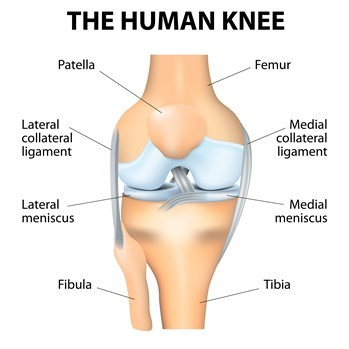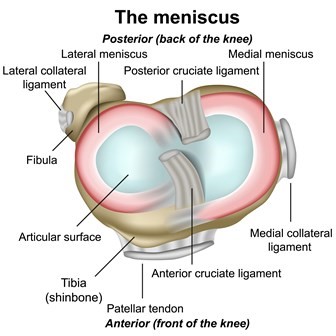
What are the menisci?
The menisci are C-shaped tissues inside the knee joint, located between the thigh (femoral) and shin (tibia) cartilage surfaces. Both are found in the joint. There is one on the inside of the knee (medial) and one on the outside (lateral).


The outer parts have adequate blood supply, but the middle and inner parts have poor blood supply. Because blood supply can affect healing, the location of a tear will affect treatment options.
What does the meniscus do in your knee?
The menisci are tissues that respond to the forces and loads that you put into the knee. They have several important functions:
- shock absorption
- load transmission (spreading weight more evenly into the knee joint)
- increasing knee joint stability
- joint lubrication
What are the types of meniscal injuries?
The menisci are a commonly injured part of the knee joint. There are two types of injury:
- acute meniscal tears (due to a specific injury)
- degenerative meniscal tears (not due to a specific injury)
It is important to know the difference between these two types of injuries, because their management is very different.

Acute meniscal tears:
- affect those under 40 years old
- are usually associated with a twisting injury
- cause a localised knee pain
- cause ‘locking’ of the knee – where the knee gets stuck in a position and you are unable to release it from that position to full straighten the knee
In younger people, meniscal tears are usually caused by twisting your knee. This often happens when playing sport, for instance football or basketball.
However, in older people, the menisci can become worn down and tears can result from more minor injuries, such as twisting awkwardly when you stand up.
How long will it take to get better?
There are no quick fixes for a meniscal tears due to the reduced blood flow into the area making healing a slow and gradual process.
However, with exercises and following lifestyle changes you may see some improvements at 3 to 6 months, although this can take longer depending on the persons overall health and long term compliance to the advice.
Do I need a scan?
MRI (Magnetic Resonance Imaging) scans give a very detailed picture of the knee, and may form part of the eventual investigation of your knee pain. However as already stated there is poor correlation between MRI findings of degenerative meniscal tears and level of pain experienced by patient.
The best way to understand your symptoms is a detail assessment by your:
- physiotherapist
- GP
- consultant
An MRI scan will only be needed if:
- surgery is being considered
- you have fully exhausted the physiotherapy management and lifestyle changes you need to make
However, it is important to note that in middle aged and older people, research studies have shown that the outcomes from arthroscopy surgery (key hole surgery) on degenerative meniscal tears were no better than those who opted to self-manage.
An x-ray can be help to determine whether there is any significant level of osteoarthritis within the knee. This is important, as if this is the case, surgery in the form of arthroscopy (key hole surgery) is often ineffective in relieving pain in the long term and will likely speed the arthritis process due to loss of the meniscus. This will often lead to the need for arthroplasty (knee joint replacement) in the future of the patient.
See our information on knee replacement surgery for more details.
Will I need surgery?
If there is true ‘locking’ of the knee following a traumatic injury, there may be an acute meniscal tear. Removal of the tissue (known as a meniscectomy) may be indicated. The goal is to improve the function and range of movement of the knee.
A referral to an orthopaedic consultant is indicated.
What can I do for my meniscal tear?
Changes in lifestyle and modifying the known causes can reduce the likelihood of symptoms getting worse. The one professional who can help you manage your symptoms is you.